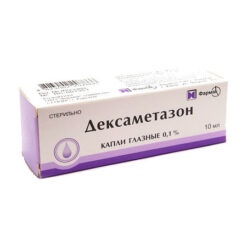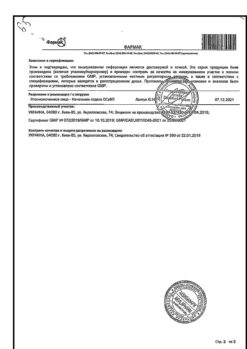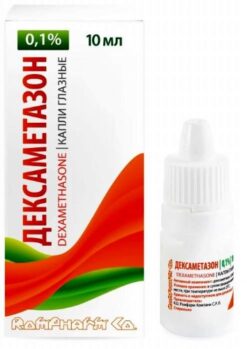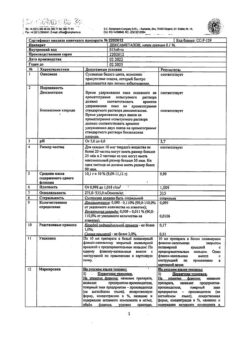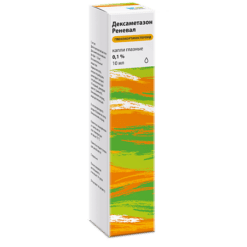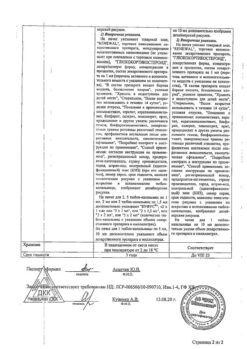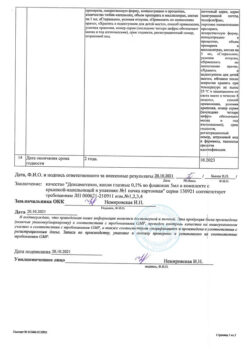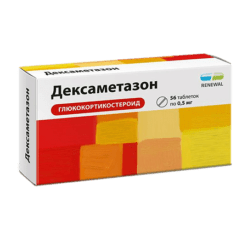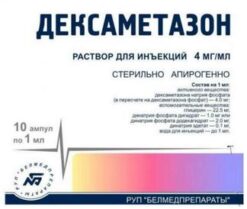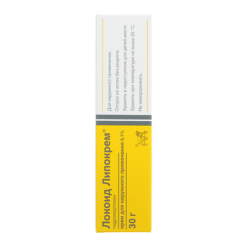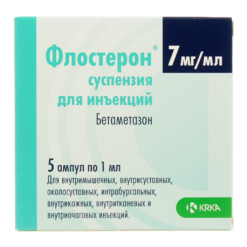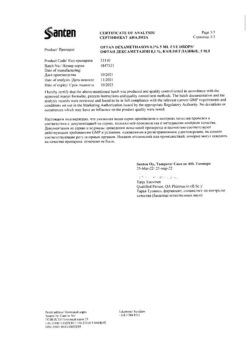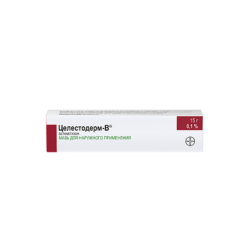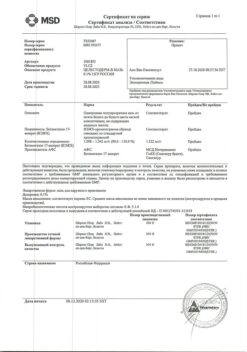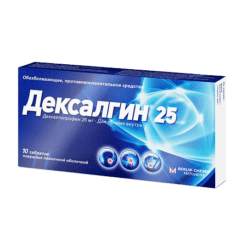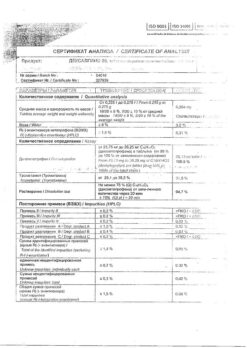No products in the cart.
Dexamethasone, tablets 0.5 mg 10 pcs
€1.48 €1.35
Out of stock
(E-mail when Stock is available)
Description
Pharmacotherapeutic group: glucocorticosteroid
ATC code: H02AB02
Pharmacological properties
Pharmacodynamics
Dexamethasone is a synthetic glucocorticosteroid (GCS), methylated fluoroprednisolone derivative, inhibits the release of interleukin-1 and interleukin-2, interferon gamma from lymphocytes and macrophages. It has anti-inflammatory, anti-allergic, desensitizing, antishock, antitoxic and immunosuppressive effects. Suppresses release of adrenocorticotropic hormone (ACTH) and beta-lipotropin by pituitary gland, but does not decrease circulating beta-endorphin. Inhibits the secretion of thyroid hormone (TSH) and follicle stimulating hormone (FSH).
Increases the excitability of the central nervous system (CNS), reduces the number of lymphocytes and eosinophils, increases red blood cell count (stimulates the production of erythropoietins).
Interacts with specific cytoplasmic receptors, forms a complex penetrating into cell nucleus, stimulates synthesis of matrix ribonucleic acid (mRNA), which induces formation of proteins, including lipocortin, that mediate cellular effects. Lipocortin inhibits phospholipase A2, inhibits the release of arachidonic acid and inhibits the synthesis of endoperoxins, prostaglandins (Pg), leukotrienes, contributing to the processes of inflammation, allergy, etc.
Effect on protein metabolism: reduces the amount of protein in the plasma (at the expense of globulins) with an increase in albumin/globulin ratio, increases the synthesis of albumin in the liver and kidneys, increases protein catabolism in muscle tissue.
Effect on lipid metabolism: increases the synthesis of higher fatty acids and triglycerides (TG), redistributes fat (fat accumulation mainly in the shoulder girdle, face, abdomen), leads to hypercholesterolemia.
Effect on carbohydrate metabolism: increases absorption of carbohydrates from the gastrointestinal tract (GIT), increases the activity of glucose-6-phosphatase, leading to increased glucose flow from the liver into the blood, increases the activity of phosphoenolpyruvate carboxylase and aminotransferase synthesis, leading to increased gluconeogenesis.
Effect on water-electrolyte metabolism: inhibits sodium ions (Na+ ) and water in the body, stimulates the excretion of potassium ions (K + ) (mineralocorticosteroid (MCC) activity), reduces the absorption of calcium ions (Ca2 +) from the gastrointestinal tract, “washes” Ca2 + from the bones, increases Ca2 + excretion by the kidneys.
Anti-inflammatory activity is associated with inhibition of eosinophils release of inflammatory mediators, induction of lipocortin formation and reduction of mast cells producing hyaluronic acid, reduction of capillary permeability, stabilization of cell membranes and organelle membranes (especially lysosomal).
Antianallergic action results from inhibition of allergy mediators synthesis and secretion, inhibition of histamine and other bioactive substances release from sensitized mast cells and basophils, reduction of circulating basophils number, suppression of lymphoid and connective tissue development, reduction of T- and B-lymphocytes quantity and mast cells, reduction of effector cells sensitivity to allergy mediators, inhibition of antibody formation, immune response alteration.
In chronic obstructive pulmonary disease (COPD) the action is mainly based on inhibition of inflammatory processes, inhibition or prevention of mucous membrane edema, inhibition of eosinophilic infiltration of submucous layer of bronchial epithelium, deposition of circulating immune complexes in bronchial mucosa, and inhibition of mucous membrane erosion and desquamation. It increases sensitivity of small and medium caliber bronchial beta-adrenoreceptors to endogenous catecholamines and exogenous sympathomimetics, decreases bronchial secretion viscosity by inhibiting or reducing its production.
Antishock and antitoxic action is associated with increase of arterial pressure (BP) (due to increase in concentration of circulating catecholamines and restoration of adrenoreceptors sensitivity to them as well as vasoconstriction), reduction of vascular wall permeability, membrane-protective properties, activation of liver enzymes involved in metabolism of endo- and xenobiotics. Immunosuppressive effect is caused by inhibition of release of cytokines (interleukin-1, interleukin-2, interferon gamma) from lymphocytes and macrophages. Inhibits the synthesis and secretion of ACTH, and secondary to the synthesis of endogenous GCS. Inhibits connective tissue reactions in the course of the inflammatory process and reduces the possibility of scar tissue formation.
Feature of action – significant inhibition of pituitary function and almost complete absence of MCS activity. Doses of 1-1.5 mg/day inhibit adrenal cortex, biological half-life (T1/2) is 32-72 hours (duration of inhibition of hypothalamic-pituitary-adrenal cortical layer system).
In terms of glucocorticosteroid activity 0.5 mg of dexamethasone corresponds to approximately 3.5 mg of prednisone (or prednisolone), 15 mg of hydrocortisone or 17.5 mg of cortisone.
Pharmacokinetics
Absorption
After oral administration is quickly and completely absorbed, the maximum concentration of dexamethasone in blood plasma is 1-2 hours. Distribution In blood plasma it is bound (60-70%) with specific carrier protein – transcortin. Crosses easily through histohematic barriers (including the blood-brain barrier and the placental barrier).
Metabolism
Metabolized in the liver (mainly by conjugation with glucuronic and sulfuric acids) to inactive metabolites. Excretion Excreted by the kidneys (a small amount of dexamethasone penetrates into breast milk). The elimination half-life is 3-5 hours.
Indications
Indications
From the endocrine system: replacement therapy for primary and secondary (pituitary) adrenal insufficiency, congenital adrenal hyperplasia, subacute thyroiditis and severe forms of post-radiation thyroiditis. Rheumatic diseases: rheumatoid arthritis (including juvenile chronic arthritis) and extra-articular lesions in rheumatoid arthritis (lungs, heart, eyes, cutaneous vasculitis).
Systemic connective tissue diseases, vasculitis and amyloidosis (as part of combination therapy): systemic lupus erythematosus (treatment of polyserositis and lesions of internal organs), Sjogren’s syndrome (treatment of lesions of the lungs, kidneys and brain), systemic sclerosis (treatment of myositis, pericarditis and alveolitis), polymyositis, dermatomyositis, systemic vasculitis, amyloidosis (replacement therapy for adrenal insufficiency), scleroderma.
Skin diseases: pemphigoid, bullous dermatitis, dermatitis herpetiformis, exfoliative dermatitis, exudative erythema (severe forms), erythema nodosum, seborrheic dermatitis (severe forms), psoriasis (severe forms), lichen, fungoid mycoses, Quincke’s edema, bronchial asthma, contact dermatitis, atopic dermatitis, serum sickness, allergic rhinitis, drug disease (hypersensitivity to drugs), urticaria after blood transfusion, systemic immune diseases (sarcoidosis, temporal arteritis).
Eye diseases: proliferative changes in the orbit (endocrine ophthalmopathy, pseudotumors), sympathetic ophthalmia, immunosuppressive therapy for corneal transplantation.
Diseases of the gastrointestinal tract: ulcerative colitis (severe exacerbations), Crohn’s disease (severe exacerbations), chronic autoimmune hepatitis, rejection reaction after liver transplantation.
Blood diseases: congenital or acquired acute pure aplastic anemia, autoimmune hemolytic anemia, secondary thrombocytopenia in adults, erythroblastopenia, acute lymphoblastic leukemia (induction therapy), myelodysplastic syndrome, angioimmunoblastic malignant T-cell lymphoma (in combination with cytostatics), plastocytoma (in combination with cytostatics), anemia after myelofibrosis with myeloid metaplasia or lymphoplasmacytoid immunocytoma, systemic histiocytosis (systemic process).
Kidney diseases: primary and secondary glomerulonephritis (Goodpasture syndrome), kidney damage in systemic connective tissue diseases (systemic lupus erythematosus, Sjogren’s syndrome), systemic vasculitis (usually in combination with cyclophosphamide), glomerulonephritis in polyarteritis nodosa, Churg-Strauss syndrome, Wegener’s granulomatosis purpura Schonlein-Henoch, mixed cryoglobulinemia, renal damage in Takayasu arteritis, interstitial nephritis, immunosuppressive therapy after kidney transplantation, induction of diuresis or reduction of proteinemia in idiopathic nephrotic syndrome (without uremia) and in renal damage due to systemic lupus erythematosus.
Malignant diseases: palliative therapy of leukemia and lymphoma in adults, acute leukemia in children, hypercalcemia in malignant neoplasms.
Other indications: tuberculous meningitis with subarachnoid blockade (in combination with adequate anti-tuberculosis therapy), trichinosis with neurological or myocardial manifestations.
Pharmacological effect
Pharmacological effect
Pharmacotherapeutic group: glucocorticosteroid
ATX code: H02AB02
Pharmacological properties
Pharmacodynamics
Dexamethasone is a synthetic glucocorticosteroid (GCS), a methylated derivative of fluoroprednisolone, which inhibits the release of interleukin-1 and interleukin-2, interferon gamma from lymphocytes and macrophages. It has anti-inflammatory, antiallergic, desensitizing, antishock, antitoxic and immunosuppressive effects. Suppresses the release of adrenocorticotropic hormone (ACTH) and beta-lipotropin by the pituitary gland, but does not reduce the content of circulating beta-endorphin. Inhibits the secretion of thyroid-stimulating hormone (TSH) and follicle-stimulating hormone (FSH).
Increases the excitability of the central nervous system (CNS), reduces the number of lymphocytes and eosinophils, increases the number of red blood cells (stimulates the production of erythropoietin).
Interacts with specific cytoplasmic receptors, forms a complex that penetrates the cell nucleus, stimulates the synthesis of matrix ribonucleic acid (mRNA), which induces the formation of proteins, including lipocortin, which mediate cellular effects. Lipocortin inhibits phospholipase A2, suppresses the release of arachidonic acid and suppresses the synthesis of endoperoxides, prostaglandins (Pg), leukotrienes, which contribute to inflammation, allergies, etc.
Effect on protein metabolism: reduces the amount of protein in plasma (due to globulins) with an increase in the albumin/globulin ratio, increases the synthesis of albumins in the liver and kidneys, increases protein catabolism in muscle tissue.
Effect on lipid metabolism: increases the synthesis of higher fatty acids and triglycerides (TG), redistributes fat (fat accumulation mainly in the shoulder girdle, face, abdomen), leads to the development of hypercholesterolemia.
Effect on carbohydrate metabolism: increases the absorption of carbohydrates from the gastrointestinal tract (GIT), increases the activity of glucose-6-phosphatase, leading to an increase in the flow of glucose from the liver into the blood, increases the activity of phosphoenolpyruvate carboxylase and the synthesis of aminotransferases, leading to the activation of gluconeogenesis.
Effect on water-electrolyte metabolism: retains sodium ions (Na+) and water in the body, stimulates the excretion of potassium ions (K+) (mineralocorticosteroid (MCS) activity), reduces the absorption of calcium ions (Ca2+) from the gastrointestinal tract, “washes out” Ca2+ from the bones, increases the excretion of Ca2+ by the kidneys.
The anti-inflammatory effect is associated with inhibition of the release of inflammatory mediators by eosinophils, induction of the formation of lipocortin and a decrease in the number of mast cells producing hyaluronic acid, with a decrease in capillary permeability, stabilization of cell membranes and organelle membranes (especially lysosomal).
The antiallergic effect develops as a result of suppression of the synthesis and secretion of allergy mediators, inhibition of the release of histamine and other biologically active substances from sensitized mast cells and basophils, a decrease in the number of circulating basophils, suppression of the development of lymphoid and connective tissue, a decrease in the number of T- and B-lymphocytes, mast cells, a decrease in the sensitivity of effector cells to allergy mediators, inhibition of antibody formation, changes in the immune system. body response.
In chronic obstructive pulmonary disease (COPD), the action is based mainly on inhibition of inflammatory processes, inhibition of development or prevention of swelling of the mucous membranes, inhibition of eosinophilic infiltration of the submucosal layer of the bronchial epithelium, deposition of circulating immune complexes in the bronchial mucosa, as well as inhibition of erosion and desquamation of the mucous membrane. Increases the sensitivity of beta-adrenergic receptors of small and medium caliber bronchi to endogenous catecholamines and exogenous sympathomimetics, reduces the viscosity of bronchial secretions due to inhibition or reduction of its production.
The antishock and antitoxic effect is associated with an increase in blood pressure (BP) (due to an increase in the concentration of circulating catecholamines and restoration of the sensitivity of adrenoreceptors to them, as well as vasoconstriction), a decrease in the permeability of the vascular wall, membrane protective properties, and activation of liver enzymes involved in the metabolism of endo- and xenobiotics. The immunosuppressive effect is due to inhibition of the release of cytokines (interleukin-1, interleukin-2, interferon gamma) from lymphocytes and macrophages. Suppresses the synthesis and secretion of ACTH, and secondarily the synthesis of endogenous corticosteroids. Inhibits connective tissue reactions during the inflammatory process and reduces the possibility of scar tissue formation.
The peculiarity of the action is significant inhibition of pituitary function and the almost complete absence of MCS activity. Doses of 1-1.5 mg/day inhibit the adrenal cortex, the biological half-life (T1/2) is 32-72 hours (duration of inhibition of the hypothalamus-pituitary-adrenal cortex system).
In terms of the strength of glucocorticosteroid activity, 0.5 mg of dexamethasone corresponds to approximately 3.5 mg of prednisone (or prednisolone), 15 mg of hydrocortisone or 17.5 mg of cortisone.
Pharmacokinetics
Suction
After oral administration, it is quickly and completely absorbed, the maximum concentration of dexamethasone in the blood plasma is 1-2 hours. Distribution In blood plasma it binds (60-70%) to a specific carrier protein – transcortin. Easily passes through histohematic barriers (including the blood-brain and placental barriers).
Metabolism
Metabolized in the liver (mainly by conjugation with glucuronic and sulfuric
acids) to inactive metabolites.
Removal
Excreted by the kidneys (a small amount of dexamethasone passes into breast milk).
The half-life is 3-5 hours.
Special instructions
Special instructions
When prescribing dexamethasone for intercurrent infections, septic conditions and tuberculosis, it is necessary to simultaneously treat with specific antibacterial therapy when using the drug in patients with latent tuberculosis, lymphadenitis after BCG vaccination, polio, acute and chronic bacterial and parasitic infections; specific therapy in patients with gastric and/or intestinal ulcers, osteoporosis.
With daily use, atrophy of the adrenal cortex develops by 5 months of treatment.
May mask some symptoms of infections; It is useless to immunize during treatment.
With sudden withdrawal of GCS, especially in the case of previous use of high doses, GCS “withdrawal” syndrome occurs (not caused by hypocortisolism): loss of appetite, nausea, lethargy, generalized musculoskeletal pain, asthenia, and acute adrenal insufficiency may also occur (low blood pressure, arrhythmia, sweating, weakness, oligoanuria, vomiting, abdominal pain, diarrhea, hallucinations, fainting, coma).
After discontinuation, relative insufficiency of the adrenal cortex persists for several months. If stressful situations arise during this period, GCS is prescribed (according to indications) for the duration. if necessary in combination with mineralocorticosteroids.
The dose of dexamethasone must be temporarily increased in stressful situations during therapy (surgery, trauma). A temporary increase in the dose of the drug in stressful situations is necessary both before and after stress.
In children, during long-term treatment, careful monitoring of the dynamics of growth and development is necessary. Children who, during the treatment period, were in contact with patients with measles or chickenpox. Specific immunoglobulins are prescribed prophylactically.
During treatment with dexamethasone (especially long-term), observation by an ophthalmologist, monitoring of blood pressure and water-electrolyte balance, as well as peripheral blood patterns and blood glucose concentrations are necessary. In order to reduce side effects, you can prescribe anabolic steroids, antacids, and also increase the intake of potassium ions in the body (eating foods rich in potassium and calcium, or taking potassium, calcium, and vitamin D supplements). Food should be rich in proteins, vitamins, and contain a small amount of fat, carbohydrates and salt.
In children during the growth period, GCS should be used only according to absolute indications and under the particularly careful supervision of the attending physician.
When using dexamethasone, there is a risk of developing severe anaphylactic reactions and bradycardia.
During drug therapy, the risk of activation of strongyloidiasis increases.
During drug therapy, careful monitoring of the condition of patients with CHF is necessary. uncontrolled arterial hypertension, injuries and ulcerative lesions of the cornea, glaucoma.
Myasthenia gravis may worsen.
With the use of corticosteroids, changes in sperm motility are possible.
Taking the drug may mask the symptoms of “peritoneal irritation” in patients with perforation of the stomach or intestinal wall.
The effect of the drug is enhanced in patients with liver cirrhosis. It must be taken into account that in patients with hypothyroidism the clearance of dexamethasone is reduced, and in patients with thyrotoxicosis it is increased.
In patients with diabetes mellitus, blood glucose concentrations should be monitored and, if necessary, the dose of hypoglycemic drugs should be adjusted.
Impact on the ability to drive vehicles and machinery.
Considering the possible side effects during therapy with Dexamethasone, care must be taken when driving vehicles, operating machinery, or engaging in other activities that require increased concentration and speed of psychomotor reactions.
Active ingredient
Active ingredient
Dexamethasone
Composition
Composition
For 1 tablet:
Active ingredient:
Dexamethasone 0.50 mg,
Excipients:
lactose monohydrate,
pregelatinized starch,
colloidal silicon dioxide,
magnesium stearate.
Contraindications
Contraindications
For short-term use for “life-saving” indications, the only contraindication is hypersensitivity to the active substance or auxiliary components of the drug.
The drug is contraindicated in patients with galactosemia, lactase deficiency and glucose-galactose malabsorption syndrome, due to the fact that the drug contains lactose.
With caution. Parasitic and infectious diseases of a viral, fungal or bacterial nature (currently or recently suffered, including recent contact with a patient) – herpes simplex, herpes zoster (viremic phase), chicken pox, measles; amebiasis, strongyloidiasis (established or suspected); systemic mycosis; active and latent tuberculosis, pre- and post-vaccination period (8 weeks before and 2 weeks after vaccination), lymphadenitis after BCG vaccination, immunodeficiency conditions (including AIDS or HIV infection).
Diseases of the gastrointestinal tract: peptic ulcer of the stomach and duodenum, esophagitis, gastritis, acute or latent peptic ulcer, recently created intestinal anastomosis, ulcerative colitis with the threat of perforation or abscess formation, diverticulitis.
Diseases of the cardiovascular system, incl. recent myocardial infarction (in patients with acute and subacute myocardial infarction, the necrosis focus may spread, the formation of scar tissue may slow down and, as a result, the heart muscle will rupture), decompensated chronic heart failure, arterial hypertension, hyperlipidemia.
Endocrine diseases: diabetes mellitus (including impaired carbohydrate tolerance), thyrotoxicosis, hypothyroidism, Itsenko-Cushing’s disease.
Severe chronic renal and/or liver failure, nephrourolithiasis; hypoalbuminemia and conditions predisposing to its occurrence; systemic osteoporosis, myasthenia gravis, acute psychosis, obesity (III-IV stage), poliomyelitis (except for the form of bulbar encephalitis), open-angle and closed-angle glaucoma, lactation period.
Side Effects
Side Effects
From the immune system: rarely – hypersensitivity reactions, decreased immune response and increased susceptibility to infections.
From the endocrine system: often – transient adrenal insufficiency, growth retardation in children and adolescents, adrenal insufficiency and atrophy (decreased response to stress), Itsenko-Cushing syndrome, menstrual irregularities, hirsuitism, transition of latent diabetes mellitus to clinically manifest, increased need for insulin or oral hypoglycemic drugs in patients with diabetes mellitus, sodium retention and water, increased potassium loss; very rarely – hypokalemic alkalosis, negative nitrogen balance due to protein catabolism.
Metabolic and nutritional disorders: often – decreased tolerance to carbohydrates, increased appetite and weight gain, obesity; infrequently – hypertriglyceridemia.
From the nervous system: often – mental disorders; uncommon – swelling of the optic nerve papillae and increased intracranial pressure (pseudotumor cerebri) after discontinuation of therapy, dizziness, headache; very rarely – convulsions, euphoria, insomnia, irritability, hyperkinesia, depression; rarely – psychosis.
From the digestive system: infrequently – peptic ulcers, acute pancreatitis, nausea, hiccups, stomach or duodenal ulcers; very rarely – esophagitis, ulcer perforation and bleeding of the gastrointestinal tract (hematomesis, melena), pancreatitis, perforation of the gallbladder and intestines (especially in patients with chronic inflammatory diseases of the large intestine).
From the senses: infrequently – posterior subcapsular cataract, increased intraocular pressure, tendency to develop secondary bacterial, fungal or viral eye infections, trophic changes in the cornea, exophthalmos.
From the cardiovascular system: infrequently – arterial hypertension, hypertensive encephalopathy; very rarely – polyfocal ventricular extrasystoles, transient bradycardia, heart failure, myocardial rupture after a recent acute infarction.
From the skin: often – erythema, thinning and fragility of the skin, delayed wound healing, striae, petechiae and ecchymosis, increased sweating, steroid acne, suppressed skin reaction during allergy tests; very rarely – angioedema, allergic dermatitis, urticaria.
From the musculoskeletal system: often – muscle atrophy, osteoporosis, muscle weakness, steroid myopathy (muscle weakness due to catabolism of muscle tissue); infrequently – aseptic bone necrosis; very rarely – vertebral compression fractures, tendon ruptures (especially with the combined use of certain quinolones), damage to articular cartilage and bone necrosis (associated with frequent intra-articular injections).
From the hematopoietic system: rarely – thromboembolic complications, a decrease in the number of monocytes and/or lymphocytes, leukocytosis, eosinophilia (as with other glucocorticosteroids), thrombocytopenia and non-thrombocytopenic purpura.
Allergic reactions: rarely – skin rash, itching, angioedema, bronchospasm, anaphylactic shock.
From the genitourinary system: rarely – impotence.
Interaction
Interaction
The simultaneous use of dexamethasone and nonsteroidal anti-inflammatory drugs (NSAIDs) increases the risk of developing and forming ulcers of the gastrointestinal tract.
The effect of dexamethasone is reduced with simultaneous use of inducers of the CYP3A4 isoenzyme (for example, phenytoin, phenobarbitone, carbamazepine, primidone, rifabutin, rifampicin) or drugs that increase the metabolic clearance of glucocorticoids (ephedrine and aminoglutethimide); in such cases, it is necessary to increase the dose of dexamethasone.
Interactions between dexamethasone and the above drugs may distort the results of dexamethasone suppression tests. If dexamethasone testing must be performed during therapy with one of these drugs, this interaction should be taken into account when interpreting test results.
The simultaneous use of dexamethasone and inhibitors of the CYP3A4 isoenzyme (for example, ketoconazole, macrolide antibiotics) may lead to an increase in the concentration of dexamethasone in the blood.
Concomitant use of drugs that are metabolized by CYP3A4 (for example, indinavir, erythromycin) may increase their clearance, which may be accompanied by a decrease in their serum concentrations.
Dexamethasone reduces the effectiveness of hypoglycemic drugs, antihypertensive drugs, praziquantel and natriuretics (the dose of these drugs must be increased); increases the activity of heparin, albendazole and potassium-sparing diuretics (if necessary, reduce the dose of these drugs).
Dexamethasone may alter the effect of coumarin anticoagulants, so more frequent monitoring of prothrombin time is recommended during therapy. Antacids reduce the absorption of dexamethasone in the stomach. Smoking does not affect the pharmacokinetics of dexamethasone.
With simultaneous use of oral contraceptives, T1/2 of glucocorticosteroids may increase, with a corresponding increase in their biological effects and an increase in the frequency of adverse side effects.
The simultaneous use of ritodrine and dexamethasone during labor is contraindicated, as this can lead to maternal death due to pulmonary edema. Concomitant use of dexamethasone and thalidomide may cause toxic epidermal necrolysis.
Potential therapeutically beneficial interactions: Concomitant use of dexamethasone and metoclopramide, diphenhydramine, prochlorperazine, or 5-HT3 receptor antagonists (serotonin or 5-hydroxytryptamine receptor type 3), such as ondansetron or granisetron, is effective in the prevention of nausea and vomiting caused by chemotherapy (cisplatin, cyclophosphamide, methotrexate, fluorouracil).
Overdose
Overdose
Single use of a large number of tablets does not lead to clinically significant intoxication.
Symptoms: possible increase in dose-dependent side effects. In this case, the dose of the drug should be reduced.
Treatment: supportive and symptomatic.
There is no specific antidote.
Hemodialysis is ineffective.
Storage conditions
Storage conditions
At a temperature not exceeding 25 °C, in original packaging
Shelf life
Shelf life
5 years
Manufacturer
Manufacturer
KRKA dd Novo Mesto, Slovenia
Additional information
| Shelf life | 5 years |
|---|---|
| Conditions of storage | At a temperature not exceeding 25 °C, in the original package |
| Manufacturer | KRKA dd Novo mesto, Slovenia |
| Medication form | pills |
| Brand | KRKA dd Novo mesto |
Other forms…
Related products
Buy Dexamethasone, tablets 0.5 mg 10 pcs with delivery to USA, UK, Europe and over 120 other countries.


